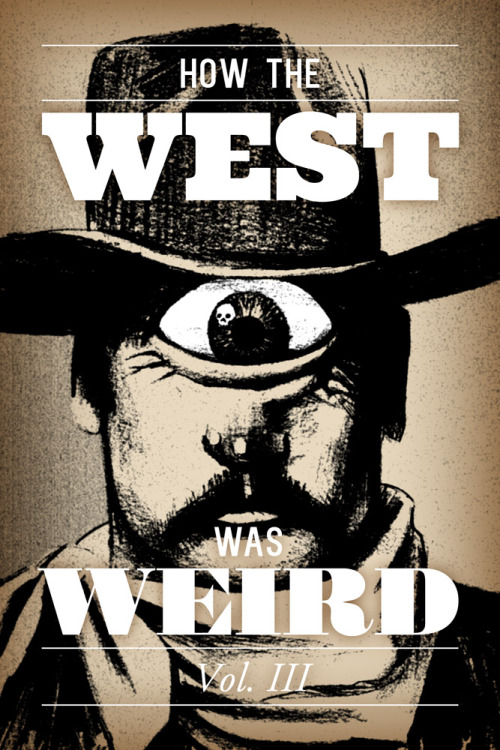* Monster Theory,
* Southwest Regional Writing,
* Environmental Writing,
* Ecocriticism (especially Dark Ecology),
* Theology (especially Ecotheology, Theology of Monsters, and Thomism),
* Metaphysics (especially Object-Oriented Ontology, Speculative Realism, Weird Realism, et. al.),
* and my own emerging (puling to be precise) theory of an 'Ecomonstrous' aesthetic.
Today I just want to scratch a few thoughts about Lafferty's fiction in relation to the Weird West subgenre. Roughly, a 'weird west' tale tends to mix classic western genre motifs with the monsters and horror of Weird Fiction (ala Lovecraft if you're Old School and Vandermeer if you're New School [and Miss Jackson if you're Nasty]).
It's kind of like Cowboys & Cthulhu.
Or Lovecraft meets L'Amour.
(art by Jim Rugg)
To me, it's a plenty stretchy genre that can also include things like Space Westerns and Future Westerns (e.g. android gunslingers) and other such genre-blending permutations (in the far reaches there are comic books series such as Cowboy Ninja Viking and Six-Gun Gorilla). And it can draw not only on roots of classic westerns but also American Indian lore and Weird Mexicana (e.g. Día de los Muertos). It overlaps a little with Spaghetti Westerns and Gonzo Westerns and Anti-Westerns (Cormac McCarthy's Blood Meridian being the quintessential specimen of this last type) and even the Southern Gothic literature of the likes of Faulkner and Flannery O'Connor. For me, it's a loose and suggestive conglomeration of tangentially related imagery and concepts.
Enter Lafferty. He's never going to truly fit any genre. He mutates everything he touches. Such is the case here. He overlaps with some of the territory of westerns because his settings are frequently those of his own lifelong Southwestern environs, mainly his native Oklahoma. Though many of his Oklohaman settings, in both novels and short stories, are urban, many also feature the wider non-urban landscape. (And even the tales set in a city - frequently Tulsa - tend to have an eye for regional features.) Since Lafferty's fiction tends to have a hefty dose of American Indian influence as well as stylistic innovations that made him at home in 1960s/70s New Wave science fiction for a while, I call his excursions into western-y territory 'buffalopunk' (think 'cyberpunk', 'steampunk', etc.).
Indeed, buffalos themselves sometimes feature in his yarns (e.g. 'Days of Grass, Days of Straw', 'Inventions Bright and New') as well as their 'byproducts' (hides, horns, meat, etc.). And just think of all the instances where some character, instead of crying bullshit, cries 'Oh, Buffalo Hokey!' And so it is with all the other fauna, flora, landscape, and general ephemera of the Southwestern region, which show up in equal doses of focused attention, background assumption, offhanded asides, and enmeshed textural detail. You may not have even noticed it, but once you're paying attention, you'll see it often: mesquite, coyotes, mesas, cattle, mountains, mountain lions, plains, 'bottoms', 'flats', crayfish, kit foxes, bears, and much, much more.
Of course, all these regional elements are either themselves 'weirded' in some way or are attendant upon the joyfully bizarre Laffertian carnival we've all come to expect from his tales: the weirdness may be in the form of magic, horror (both visceral and ghostly), mad science, aliens, monsters, extreme violence or gore, dystopia, and general metaphysical antics (doubled people, landscapes that won't behave properly, skies raining everything but cats and dogs, talking fauna, persons filled with sawdust or confetti, etc.). Hence the '-punk' suffix.
You can think of your own list of stories that feature strains of Lafferty's buffalopunk, but some that spring to my mind are (in addition to the few named above) 'Boomer Flats', 'Happening at Chosky Bottoms', 'Narrow Valley', 'And Walk Now Gently Through the Fire', 'Sodom and Gomorrah, Texas' and 'Oh Tell Me Will It Freeze Tonight'. These all take place in the Southwest, but even in Lafferty's offworld stories there is often a noticeable element of buffalopunk: e.g. 'Pig in a Pokey', 'Snuffles', 'Golden Trabant', 'Smoe and the Implicit Clay', etc. (Also, a number of his earliest stories, which are only recently beginning to come to light to a wider audience, are quite regional, though some are perhaps a little lighter on overtly freakish 'punk' elements: e.g. 'The Wagons', 'Rain Mountain', 'Ghost in the Corn Crib', etc.)
His novel most relevant to this theme is obviously his historical epic of the Choctaws Okla Hannali (1972), but The Reefs of Earth (1968) comes a close second as a science fiction novel in full Southwestern Gothic-Weird mode, with its backwoods setting, murderous alien children, lively Indian mounds and so on.
But what provoked this whole meditation for me was that I ran smack into a whole chapter of buffalopunk (IV: 'Liar on the Mountain') in my now third re-reading of Fourth Mansions (1969). I'd remembered that the landscape behaved strangely in this passage, but I didn't remember how repletely Weird West this chapter was, complete with a Texas-Mexico setting (the same territory as McCarthy's Blood Meridian). There is a very western 'mesquite and sagebrush' landscape described, which is rolling like the sea (an image of western plains I've seen in sources as diverse as McCarthy and Zane Grey, but here rather more literalised) and taking on impossible dimensions the further into it they go. There's a preternatural guardian, a short bloody boar hunt, a cave-cooked meal, and even a many-tentacled black monster in a fountain in this chapter. A delightful excursion into weird western!
The rest of the novel is very Tulsa urban, and still evinces not a little of buffalopunk, but that Lafferty just went full western in this chapter kind of freshly hit me and reminded me how frequently recurring is his element of buffalopunk. Now I'm going to be trying to catalogue all its appearances and allusions. (What, me obsessive? Pshh.)

2 comments:
And don't forget Pickens and the green buffalo.
Yes, of course! A great tall tale segment in Okla. Thanks for the reminder...
Post a Comment